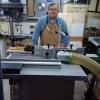I've been trying to figure out the wiring needs for the VFD to run the 3 phase motor on the bandsaw I've been posting about lately, and have run into a couple of general questions about VFD wiring that have gotten me pretty confused. I'm hoping someone here can steer me in the right direction.
Can I plug a 2 HP VFD into the existing 50 amp welder outlet in my shop? It is the only 240V circuit I have, though there is room in the panel to add a new one if I have to. I will unplug the VFD when I am out of the shop or not using it for a while to reduce the chances of lightning or other damage.
What kind of wire do I need to connect a 2 HP 240V VFD to a 1.5 HP 3 phase motor? What I've been reading seems to say that any kind of suitable wire can be used on the input side, but there is a lot being discussed about the output side and whether the wires need to be individually shielded to avoid interference, or whether they need to be in a properly grounded steel conduit, or what. The wire run from the VFD to the motor will be about 3 feet or less. On the drill press I set up with a VFD a few years ago I just used some stranded copper wire I had around, but that was only a 1 HP with 120V input and the VFD is right beside the motor. I'll be grateful for any advice about these matters.





 Reply With Quote
Reply With Quote

